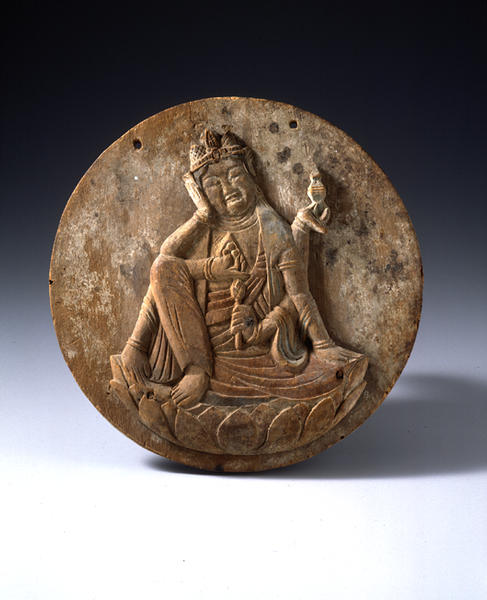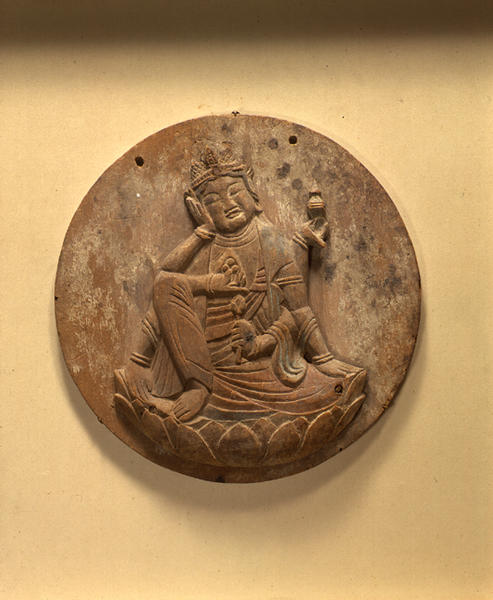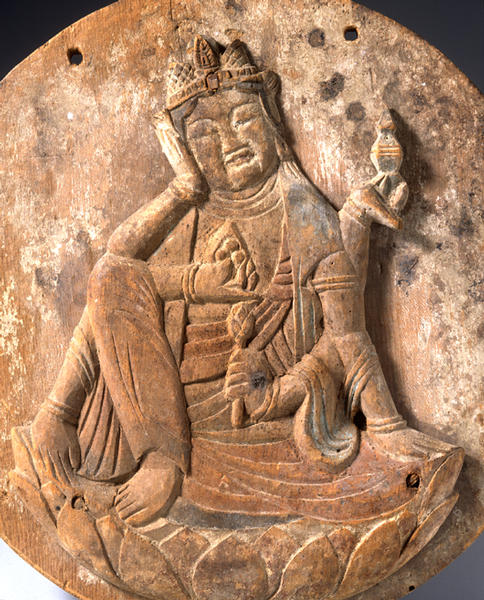Plaque with Nyoirin-Kannon (s: Cintamanicakra)
- Heian period
- 13-14c
- Wood with polychrome
- D-20
Catalogue Entry
Round plaques showing Buddha in bas-relief perhaps originated from the practice of chasing a deity on a mirror, which was believed to be a dwelling of gods. Alternatively, these plaques might have their origin in painted copies of figures in Esoteric Buddhism, with the entire painting enclosed in a circle; these paintings were intended to symbolize the main object of worship in shrines. These plaques were hung from the front of shrines and served as intermediaries between the faithful and the object of worship which they were not permitted to see. The hanging plaques of Buddha gained popularity during the Heian period (794-1185), a fact that constitutes the reason why there are many works found from the Kamakura (1185-1336) and Muromachi periods (1392-1573). This is attributed to the fact that, although these plaques were originally produced as the object of worship, they became popular later as votive plaques, which were left at a shrine or temple when believers came to pray.
In the present work, a figure of a Kannon, bas-reliefed on wood, is nailed to a round wooden plaque, which is painted white, with three wooden nails. Two holes are visible at the top through which a string for hanging is threaded. The Kannon's first right hand is held at its cheek, the second right hand is at its chest holding a sacred gem, and the third right hand touches the lotus flower with its outstretched fingers. Its first left hand also rests on the lotus flower with stretched fingers, and the second left hand holds up an object that resembles a pagoda. Speculating from the wooden seated Nyoirin Kannon figure in Komatsuji Temple in Ibaraki Prefecture and other similar works, the pagoda may be a transmutation of the sacred wheel. The third left hand holds up a bud of the lotus flower before its chest. Almost all the colors have now been lost, but presumably the crown, the heavenly scarf on its arms, and the lotus flower base were originally decorated in verdigris; and the lips of the Kannon, the scarf at its chest, the skirt, and the lotus petals were probably painted in red. The hair, eyes, and the hem of the skirt now appear dark but they were likely ultramarine in color.
The style of this work is very similar to the eleven-faced Kannon plaque in the Kyoto National Museum that bears an inscription "Nyaku oji" on the back. Despite the fact that the present work is only in half round relief, the image is highly expressive, a stylistic feature which enables dating this plaque to the Heian period. On the back "Hoppo Nyoirin" is written in black ink.


